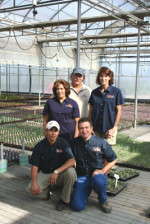Keeping Variety Alive

While walking me around her Blooming Nursery, Grace Dinsdale makes sure to point out the old dairy barn that now houses the offices for her floriculture business. It’s recognizable to customers, she says. A loyal and long-time staff works hard at keeping flower varieties alive that are threatened by commoditization and keeps a sense of professionalism and community flowing through the business. A background in farming meant Dinsdale was keenly aware of commodity growing and its challenges. From its beginning in 1982, she envisioned a Blooming Nursery that would be free to make its own choices.
“I knew we wanted to be in a market that was more under our control,” Dinsdale explains. “We can make decisions based on what we want our price to be, how many of something we’re going to grow, how we we’re going to schedule it and who we we’re going to sell to. I didn’t want to have any one customer be able to dictate these important business decisions to us or significantly damage us if they went away.”
Today, Blooming Nursery provides herbaceous perennials, flowering shrubs, herbs and ornamental grasses to independent garden centers and landscapers as well as liners and bare root stock to finish growers. About 20 percent of what the nursery grows for finished containers is from division, with 25 acres of plants in the ground. A wide variety of crops, more than 1,900 varieties in production, keeps a workforce of 80 to 90 busy for more than 10 months of the year. Managing that complicated inventory and keeping it fresh is the company’s biggest challenge, but also its biggest opportunity, according to Dinsdale.
Blooming Nursery considers itself more than a place to buy plants. It’s a place where plants are saved from extinction. If they’re considered merit-worthy, stock from perennials not currently in production is archived, allowing for varieties to come back into production in the future. The simplification of variety offerings in the industry is worrisome to Dinsdale.
“This simplification taking place largely at the big box stores creates a great opportunity for independents and the growers that supply them to further differentiate themselves by continuing to offer the diversity that gardeners want and need. It’s amazing how quickly you can lose varieties,” she says. “If they’re dropped by the industry, they can disappear in a short period of time. Long term, I’m afraid it limits gardeners’ choices drastically and ultimately will be bad for the future of gardening and horticulture.”
Blooming Nursery follows the adage of growing not only a wide variety of products, but growing them the right way — slowly and cool, which has helped its products thrive over time.
Back In The Beginning
Although Blooming Nursery began as a wholesale finish grower, an on-site retail outlet was added within the first 6 months and continued selling direct to gardeners for 10 years. In the early ’90s, the company switched to selling liners and closed its retail operation.
“Our retail shop was very successful and we had a lot of fun doing it, but we were all working so hard on the wholesale side and needed the space, so we had to stop,” Dinsdale explains. “We realized that selling liners fit better with the finished wholesale side than retail did and also helped to support the tremendous expense of maintaining stock for such a long list of varieties.” But retail customers still wanted what Blooming Nursery was selling and wanted to know how they could recognize it at other retailers. That’s when the Blooming Advantage brand was born. A burgundy pot and later a trademarked logo was the formula that worked.
“I really wanted a color that would be complimentary to the plant, that would make it look more striking,” Dinsdale says. “We wanted it to be understated, but identifiable.”
This word-of-mouth branding used what, according to Dinsdale, any good marketing program needs — a distinct product and lots of time. It takes more than two or three years and a lot of hype to make a good brand.
“Research has shown that gardeners are not paying so much attention to brands in our industry. I think that’s probably true when it’s all advertising and promotion, without discernible differences in product and quality,” she says.
Looking Inward
With a branded and popular product line already in the market, Blooming Nursery has had time to evaluate processes and personnel. Over the last few years, new staff has been added to an already loyal and talented staff to add skills the company needed to improve, organizational efficiency, communications and process systems, in particular.
A new software system from SBI Nursery for tracking inventory by sales-ready date has also been a big recent change. Eight handheld computers are used to log transplants, cuttings and movement in production areas. While the entire nursery isn’t completely wireless yet, it’s in the works.
“What we’re working towards is getting full transparency throughout the organization, so everyone can look in and see exactly what we have, when it’s going to be ready, where it is and even notes about its condition, as well as what’s projected for the future,” Dinsdale says.
Over the next two years, the company also plans to add two acres of greenhouse space and is looking to expand into is co-branding with retailers and pre-pricing on the dock. The challenge is the short runs that would be required, as the company often ships up to 200 different items per order, one flat at a time. Pre-pricing, however, would give retailers more time to sell fresh inventory.
“Otherwise, when plants get to the garden center, they’re sitting on racks waiting for someone to price them,” Dinsdale says. “That doesn’t help us or them.” Ultimately, Blooming Nursery wants to help consumers become gardeners, even if it’s by accident.
“Maybe they don’t even mean to be a gardener, but they end up with a plant,” she says. “We want to make sure that it’s a good experience. We don’t want any one of them to buy a plant, have it die and have them think, ‘Well, I’m terrible at that. I’m not going to do that anymore.’
“If retailers are selling low-quality plants and plants that aren’t tested for the area, that’s very likely to happen. People will take it personally. They tend to think it’s their fault.”
Keeping a well-educated and hard-working staff is also paramount. Different perspectives and industry experiences have brought new, smoother, more accurate communication and process improvements, with more to come.
“Small things like that make a difference in efficiency,” Dinsdale says. “I’m really excited about where we’re heading.”









